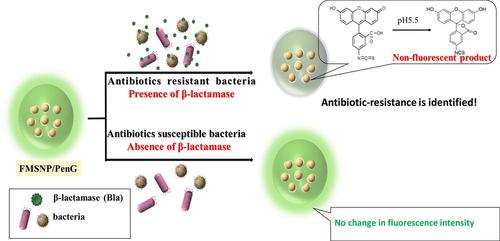当前位置:
X-MOL 学术
›
Chemistryopen
›
论文详情
Our official English website, www.x-mol.net, welcomes your
feedback! (Note: you will need to create a separate account there.)
Fluorescent Mesoporous Nanoparticles for β‐Lactamase Screening Assays
ChemistryOpen ( IF 2.5 ) Pub Date : 2020-10-23 , DOI: 10.1002/open.202000221 Srikrishna Tummala, Wei‐An Huang, Bo‐Hong Wu, Kai‐Chih Chang, Yen‐Peng Ho
ChemistryOpen ( IF 2.5 ) Pub Date : 2020-10-23 , DOI: 10.1002/open.202000221 Srikrishna Tummala, Wei‐An Huang, Bo‐Hong Wu, Kai‐Chih Chang, Yen‐Peng Ho

|
We present a sensitive and rapid screening method for the determination of β‐lactamase activity of antibiotic‐resistant bacteria, by designing a pH‐sensitive fluorescent dye‐doped mesoporous silica nanoparticle encapsulated with penicillin G as a substrate. When penicillin G was hydrolysed by β‐lactamase and converted into penicilloic acid, the acidic environment resulted in fluorescence quenching of the dye. The dye‐doped mesoporous nanoparticles not only enhanced the β‐lactamase‐catalyzed reaction rate but also stablized the substrate, penicillin G, which degrades into penicilloic acid in a water solution without β‐lactamase. Twentyfive clinical bacterial samples were tested and the antibiotic resistant and susceptible strains were identified. The proposed method may detect the presence of β ‐lactamases of clinically relevant samples in less than 1 hour. Moreover, the detection limit of β‐lactamase activity was as low as 7.8×10−4 U/mL, which was determined within two hours.
中文翻译:

用于 β-内酰胺酶筛选分析的荧光介孔纳米颗粒
我们通过设计一种以青霉素 G 为底物封装的 pH 敏感荧光染料掺杂介孔二氧化硅纳米颗粒,提出了一种灵敏、快速的筛选方法,用于测定抗生素耐药细菌的 β-内酰胺酶活性。当青霉素G被β-内酰胺酶水解并转化为青霉霉酸时,酸性环境导致染料的荧光猝灭。掺杂染料的介孔纳米颗粒不仅提高了β-内酰胺酶催化的反应速率,而且稳定了底物青霉素G,在没有β-内酰胺酶的水溶液中,青霉素G降解为青霉唑酸。对二十五个临床细菌样本进行了检测,并鉴定了抗生素耐药菌株和敏感菌株。所提出的方法可以在不到 1 小时的时间内检测出临床相关样品中是否存在 β-内酰胺酶。此外,β-内酰胺酶活性的检出限低至7.8×10 -4 U/mL,2小时内即可测定。
更新日期:2020-10-26
中文翻译:

用于 β-内酰胺酶筛选分析的荧光介孔纳米颗粒
我们通过设计一种以青霉素 G 为底物封装的 pH 敏感荧光染料掺杂介孔二氧化硅纳米颗粒,提出了一种灵敏、快速的筛选方法,用于测定抗生素耐药细菌的 β-内酰胺酶活性。当青霉素G被β-内酰胺酶水解并转化为青霉霉酸时,酸性环境导致染料的荧光猝灭。掺杂染料的介孔纳米颗粒不仅提高了β-内酰胺酶催化的反应速率,而且稳定了底物青霉素G,在没有β-内酰胺酶的水溶液中,青霉素G降解为青霉唑酸。对二十五个临床细菌样本进行了检测,并鉴定了抗生素耐药菌株和敏感菌株。所提出的方法可以在不到 1 小时的时间内检测出临床相关样品中是否存在 β-内酰胺酶。此外,β-内酰胺酶活性的检出限低至7.8×10 -4 U/mL,2小时内即可测定。











































 京公网安备 11010802027423号
京公网安备 11010802027423号